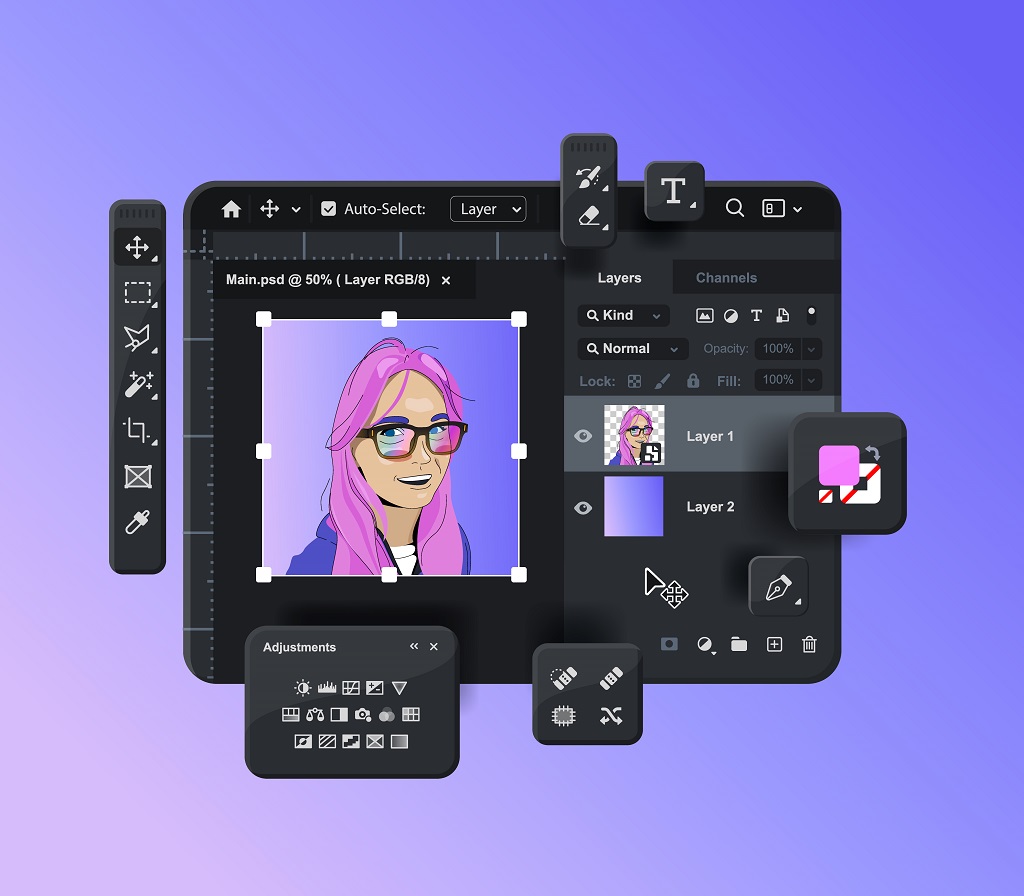Photoshop is a powerful and widely-used software that revolutionized the world of digital imaging. It has become an essential tool for photographers, graphic designers, and artists alike. With its impressive array of features and tools, Photoshop allows users to manipulate and enhance images in ways that were once unimaginable. From retouching imperfections to creating stunning visual effects, Photoshop offers endless possibilities for creative expression. Its intuitive interface and user-friendly design make it accessible to both professionals and amateurs, enabling anyone with a creative vision to bring their ideas to life. With Photoshop, users can adjust color and lighting, remove unwanted objects, and even completely transform the composition of an image. The software’s advanced capabilities also extend to text editing, 3D modeling, and video editing, making it a versatile tool for various creative endeavors. Moreover, Photoshop boasts an extensive library of filters, brushes, and plugins that allow users to further personalize their work and achieve unique and striking results. It has truly revolutionized the world of digital art and has become an indispensable tool for professionals in various industries. From magazines and advertisements to movie posters and web design, Photoshop has left an indelible mark on the visual landscape of our modern world. However, it is important to remember that while Photoshop can be a valuable tool for creativity and self-expression, its misuse can also lead to the distortion of reality. In today’s era of digital manipulation, it is essential to exercise caution and responsibility when using Photoshop to ensure that the images we create and share reflect the truth and maintain integrity.

What is Photoshop?
Photoshop is a powerful software application that has revolutionized the world of digital image editing. It is a tool used by professionals and enthusiasts alike to manipulate and enhance photographs and other visual elements. With its wide array of features and tools, Photoshop allows users to alter images in a variety of ways, from simple touch-ups to complex and intricate modifications. This software has become synonymous with image editing, and its impact on the creative industry cannot be overstated.
At its core, Photoshop is a raster graphics editor, meaning it is specifically designed to work with pixel-based images. It offers a vast range of tools and functionalities that enable users to adjust colors, tones, and other visual elements to achieve desired effects. These tools include cropping, resizing, retouching, and refining techniques, among others. With the ability to remove imperfections, adjust exposure, and manipulate objects within an image, Photoshop empowers users to transform ordinary photographs into stunning works of art.
One of the most popular features of Photoshop is its layer-based editing system. This allows users to work on different parts of an image separately, stacking layers on top of each other and adjusting their properties individually. Layers can contain various elements, such as text, shapes, or even other images, and can be manipulated independently to achieve desired results. This flexibility and non-destructive editing capability make Photoshop an indispensable tool for graphic designers, photographers, and digital artists.
Photoshop also offers a wide range of filters and effects that can be applied to images, providing endless creative possibilities. Users can add artistic effects, simulate different lighting conditions, apply textures, or even create surreal and fantastical compositions. This versatility ensures that Photoshop remains at the forefront of image editing software and continues to inspire creative expression.
Beyond its core functionalities, Photoshop has also become a platform for collaboration and sharing within the creative community. Through online platforms and communities, users can showcase their work, exchange ideas, and provide feedback on others’ creations. This collaborative aspect has fostered a sense of community among Photoshop users, fueling innovation and pushing the boundaries of what is possible in digital image editing.
While Photoshop is primarily used for editing photographs, its applications extend far beyond that. It has become an essential tool for web designers, allowing them to create visually appealing layouts and graphics for websites. Additionally, Photoshop is widely used in the advertising industry to create eye-catching advertisements and promotional materials. Its versatility and wide range of applications make it an indispensable tool in various industries and professions.
In conclusion, Photoshop is a powerful software application that has revolutionized the world of digital image editing. With its extensive range of tools and functionalities, it allows users to manipulate and enhance images in countless ways. From simple touch-ups to complex compositions, Photoshop empowers users to unleash their creativity and achieve stunning results. Its impact on the creative industry cannot be overstated, and its continued development ensures that it will remain at the forefront of image editing software for years to come.
How does Photoshop work?
Photoshop, an incredibly powerful image editing software developed by Adobe, revolutionized the way we manipulate and enhance digital images. This sophisticated program uses a complex set of algorithms and tools to allow users to modify and transform photographs with astonishing precision and creativity. At its core, Photoshop works by manipulating pixels, the smallest units of an image, to alter its appearance. By understanding the underlying principles and tools within the software, users can seamlessly blend, retouch, and manipulate images to achieve desired results.
One of the fundamental aspects of Photoshop is its ability to work with layers. These layers act as transparent sheets that can be stacked upon each other, allowing users to make adjustments and modifications to specific parts of an image without affecting the rest. This non-destructive editing technique ensures that any changes made can be easily reversed or modified, providing users with an enormous amount of flexibility in their creative process. Layers can be manipulated by adjusting their opacity, blending modes, and applying various effects, enabling users to create stunning compositions and seamlessly merge multiple elements together.
Another key feature of Photoshop is its wide range of selection tools. These tools enable users to isolate specific areas or objects within an image, allowing for precise editing and manipulation. Simple selection tools like the rectangular or elliptical marquee tool provide basic selection options, while more advanced tools like the magic wand or quick selection tool make it easier to select complex shapes or objects with similar characteristics. Once an area is selected, users can apply a plethora of adjustments, such as color correction, retouching, or even removing unwanted elements from the image entirely.
To enhance the overall appearance of an image, Photoshop offers a variety of powerful tools and filters. The software provides users with the ability to adjust color balance, brightness, contrast, and saturation to fine-tune the overall look and feel of an image. Additionally, a wide array of artistic filters and effects can be applied to transform ordinary photographs into visually stunning works of art. These filters can simulate various traditional art techniques, such as oil painting or watercolors, adding a unique touch to the final output.
Furthermore, Photoshop enables users to retouch and enhance portraits with remarkable precision. The software includes tools specifically designed for retouching, allowing users to remove imperfections, smooth skin, and even reshape facial features. With the help of tools like the healing brush or clone stamp, blemishes and unwanted elements can be seamlessly removed, resulting in flawless and professional-looking portraits.
In conclusion, Photoshop is a powerful and versatile image editing software that enables users to manipulate and enhance digital images with incredible flexibility and precision. By leveraging layers, selection tools, adjustment options, and artistic filters, users can seamlessly blend, retouch, and transform photographs, unlocking endless creative possibilities. Whether it’s enhancing landscapes, creating stunning compositions, or retouching portraits, Photoshop remains an essential tool for photographers, designers, and artists around the world.

What are Photoshop’s features?
Photoshop, an incredibly popular and widely-used software, boasts an impressive array of features that have revolutionized the world of digital image editing. This powerful tool offers a wide range of capabilities that allow users to manipulate and enhance images with unparalleled precision and creativity. One of its standout features is the ability to retouch and restore photographs, enabling users to remove imperfections, smooth skin, and even change the overall appearance of a subject. Additionally, Photoshop provides users with an extensive set of tools for creating and manipulating graphics, such as brushes, shapes, and filters. These features allow for the creation of stunning visual effects and designs, making Photoshop an indispensable tool for graphic designers, photographers, and artists alike. Moreover, the software offers advanced options for adjusting colors, tones, and exposure, providing users with complete control over the overall look and feel of their images. This ensures that photographs can be modified to convey the desired mood and atmosphere effectively. Furthermore, Photoshop’s versatile text editing capabilities allow for the creation of eye-catching typography and the integration of text seamlessly into images. The software also offers various selection tools, enabling users to isolate specific elements within an image and manipulate them individually or as a group. This feature is particularly valuable for tasks such as removing backgrounds, creating composite images, or applying selective adjustments to specific areas. Additionally, Photoshop provides users with the ability to work with multiple layers, allowing for non-destructive editing and enabling them to combine different elements seamlessly. This feature is especially valuable when creating complex compositions or collages. Furthermore, Photoshop offers a variety of export options, allowing users to save their work in a wide range of file formats suitable for different purposes, including web publishing, printing, or sharing on social media platforms. Additionally, Photoshop’s integration with other Adobe Creative Cloud applications, such as Illustrator and InDesign, further enhances its capabilities and provides users with a seamless workflow for creating professional-quality designs and publications. Overall, Photoshop’s extensive set of features empowers users to unleash their creativity and transform ordinary images into extraordinary works of art.
What is the most recent version of Photoshop?
The most recent iteration of Photoshop, the renowned image editing software, is the latest version to hit the market. This advanced software offers users a plethora of innovative features and tools, catering to the needs of both professional photographers and amateurs alike. Boasting an array of enhancements and updates, the newest iteration of Photoshop has garnered widespread attention and acclaim within the creative community. With its intuitive user interface and an extensive range of editing options, this latest version aims to provide users with an unparalleled editing experience, further solidifying Photoshop’s reputation as the leading software in the industry.

Who uses Photoshop?
Photoshop, a powerful image-editing software developed by Adobe, has become an essential tool for a wide range of individuals and industries. From amateur photographers to professional graphic designers, Photoshop has found its place in the hands of countless creative minds. Artists and photographers use this software to enhance and manipulate their images, bringing their imaginative visions to life. In the field of advertising, Photoshop is utilized to create eye-catching visuals that captivate audiences and convey a brand’s message effectively. Moreover, Photoshop is extensively used in the fashion industry to retouch and perfect models’ appearances, often resulting in unrealistic beauty standards. Additionally, professionals in the publishing world rely on Photoshop to design stunning book covers and layouts that engage readers. The software’s versatility makes it a beloved tool for web designers, enabling them to create visually appealing websites and user interfaces. Furthermore, educators and students often employ Photoshop in various creative projects, allowing them to explore their creativity and develop essential design skills. Overall, Photoshop is not limited to a particular group of people; instead, it is a tool that is embraced by individuals across different industries, offering them endless possibilities for image manipulation and design.
What types of projects are best for Photoshop?
Photoshop, being a versatile and powerful image editing software, can be utilized for a wide range of projects. Its capabilities extend far beyond mere retouching and manipulation of photographs; it can be employed to create stunning digital artwork, design eye-catching logos and graphics, enhance web designs, develop engaging social media content, and even produce realistic visual effects. The beauty of Photoshop lies in its ability to cater to various industries and individuals, making it an invaluable tool for graphic designers, photographers, web developers, and artists alike.
One of the primary applications of Photoshop is in the realm of graphic design. Designers can utilize the software to create visually appealing logos, brochures, posters, and business cards. Photoshop’s extensive collection of brushes, filters, and effects allows designers to experiment with different styles and aesthetics, enabling them to produce unique and captivating visuals. Moreover, the software’s layer-based system and advanced tools provide designers with the flexibility to manipulate and arrange elements precisely, resulting in professional-looking designs.
Photographers, both amateur and professional, can greatly benefit from Photoshop’s features as well. The software enables photographers to enhance the quality of their images by adjusting brightness, contrast, and color balance. Additionally, Photoshop offers advanced retouching tools, which allow photographers to remove blemishes, wrinkles, or unwanted objects from their photos. With the ability to apply various filters and effects, photographers can also add artistic touches to their images, transforming them into captivating pieces of art.
Web developers can utilize Photoshop to create visually appealing and user-friendly web designs. The software’s grid system and alignment tools assist in creating well-structured layouts, ensuring optimal usability and readability. Moreover, Photoshop’s ability to generate web-friendly assets and export graphics in different file formats makes it an indispensable tool for web development projects. By using Photoshop, web developers can seamlessly integrate their designs into popular content management systems, resulting in visually stunning and responsive websites.
Social media has become an integral part of our daily lives, and businesses are increasingly utilizing platforms such as Instagram, Facebook, and Twitter to engage with their audience. Photoshop can be immensely helpful in creating eye-catching and shareable social media content. With its wide array of filters, text effects, and graphics, designers can develop visually appealing posts and advertisements that grab users’ attention. Additionally, Photoshop’s ability to create animated GIFs and videos allows businesses to create dynamic and captivating content, further enhancing their social media presence.
Photoshop’s capabilities extend beyond traditional graphic design and photography projects. It can be used in various industries, such as film and video production, where visual effects play a crucial role. The software offers a wide range of tools and features that enable artists to create stunning and realistic visual effects, such as explosions, fire, or even fantastical creatures. By utilizing Photoshop, artists can seamlessly integrate these effects into their footage, enhancing the overall visual storytelling experience.
In conclusion, Photoshop’s versatility and extensive range of features make it an invaluable tool for a wide array of projects. From graphic design and photography to web development and social media content creation, Photoshop provides the necessary tools to produce visually appealing and professional-looking results. Its ability to cater to various industries and individuals ensures that it remains an essential software for creative professionals worldwide.
